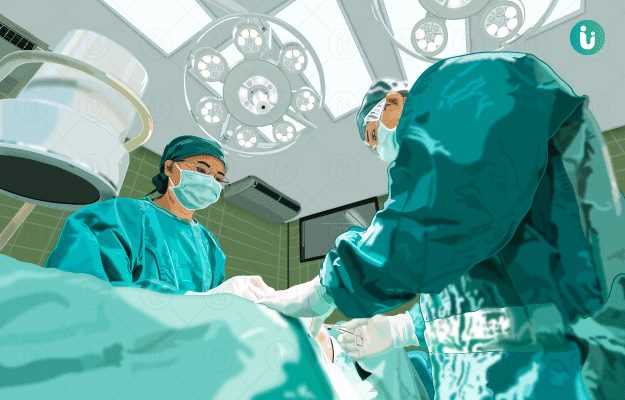Summary
Omentopexy involves surgically fixing the omentum in place. The omentum is a fatty structure formed from the peritoneum, the lining inside the abdominal cavity. It can adhere to the abdominal wall and accelerate the healing process. Omentopexy helps manage conditions like perforated peptic ulcer, catheter insertion in the peritoneal layer, and Buerger’s disease. You will need to fast for at least eight hours before the surgery. This surgery is performed using general anaesthesia to keep you relaxed and pain-free during the surgery. The procedure may differ based on the condition. Once you reach home, you will have to restrict a few activities and take proper care for fast recovery.
- What is omentopexy?
- Why is omentopexy recommended?
- Who can and cannot get omentopexy?
- What preparations are needed before omentopexy?
- How is omentopexy done?
- How to care for yourself after omentopexy?
- What are the possible complications/risks of omentopexy?
- When to follow up with your doctor after an omentopexy?
What is omentopexy?
Omentopexy is a surgical procedure to fix the omentum by suturing it to the abdominal wall. The procedure is done for the management of multiple conditions like perforated peptic ulcer, fixation of a catheter (small, thin tube) in peritoneal dialysis, and Buerger’s disease. The omentum is a fat-rich structure formed from the inner layer of the peritoneum (lining of the abdomen). It possesses good healing properties and is present as a sheet that lies over the intestines.
Why is omentopexy recommended?
Omentopexy is performed in the following conditions:
- Peritoneal dialysis: Peritoneal dialysis is done to purify blood in case of kidney failure. Omentopexy is done prophylactically to prevent obstruction of the catheter by the omentum during dialysis.
- Perforated duodenal ulcer: Duodenal ulcer is an open sore in the initial section of the small intestine. It can lead to a hole in the intestine called a perforation. Omentopexy can help by improving blood supply and promoting healing in this area. The symptoms of this condition are as follows:
- Vomiting
- Abdominal pain
- Chest pain
- Nausea
- Feeling of fullness
- Weight loss
- Heartburn
- Tiredness
- Blood in vomit
- Buerger’s disease: In this condition, the blood vessels of the hands and feet are blocked, mainly with a clot. This can lead to ulcer and pain in limbs. Omentopexy can help with healing of both ulcers and pain.
What preparations are needed before omentopexy?
Before undergoing omentopexy, you will need the following preparation:
- Your doctor will ask you to undergo a few diagnostic tests, including computed tomography (CT) scan or Doppler study (a type of sonography that involves measuring the amount of blood flow through blood vessels) to check the conditions mentioned earlier.
- Tell your doctor about all the medicines that you take, including prescribed or non-prescribed medications, mineral, herbs, vitamins, and supplements, with your doctor.
- You will need to fast for at least eight hours before this surgery.
- Let your surgeon know if you have a fever, flu, etc., in the days leading to the operation. In such a case, your surgery may be postponed.
- Also, let your doctor know if you have any allergies to foods, medicines, or surgical components like iodine, skin tapes, latex, adhesive, or skin cleansing solution.
- You will be asked to stop taking blood-thinners like aspirin, ibuprofen, warfarin, vitamin E, or clopidogrel for a minimum of two weeks before the surgery.
- If you smoke, quitting this habit can help you recover fast after the surgery.
- Arrange for a family member, friend, or a responsible adult to drive you home after your discharge from the hospital.
- You will be asked to sign an approval or consent form to assure your willingness for the procedure.
How is omentopexy done?
This surgery is usually performed by laparoscopic method. This method has a low risk of infection and you will have a short hospital stay after the surgery.
Once you are admitted to the hospital,
- The medical staff will ask you to change into a hospital gown.
- You will lie on an operating table in supine position i.e., sleeping on your back.
- An intravenous (IV) line will be started in your arm to provide you medications and fluids during and after the procedure.
- An anesthesiologist will then administer general anaesthesia (to keep you relaxed and pain-free during the surgery) to you.
- You may also receive antibiotics (to reduce chances of infection) before the surgery.
- A nasogastric tube will be inserted through your nose into your stomach to prevent spillage of contents of your stomach into your peritoneum.
- A urinary catheter will be placed into your bladder to drain out urine.
- The medical team will constantly monitor your vital functions, including your blood pressure and heart rate throughout the surgery.
The following steps are performed to manage Buerger’s disease and perforated peptic ulcer:
- The surgeon will insert three trocars (a tube with sharp edges) near your belly button to access the inside of your abdomen; the incision points of these trocars will form an equilateral triangle.
- He/she will explore your abdomen to locate the perforated area.
- Once the area is located, the surgeon will stitch the omentum in the region onto the perforation using figure of eight stitches to cover the hole.
- Finally, the surgeon will place drains in the wound (to remove any accumulated fluids) and stitch your skin to close the incisions.
For peritoneal dialysis, the following steps are performed:
- The surgeon will use three trocars to make cuts over your abdominal area.
- He/she will inflate your abdomen with gas for better visualisation of your internal organs.
- The surgeon will check your abdomen for the presence of any adhesions (scar tissue bands that bind two tissues/organs that are not normally joined together).
- He/she will bring your small intestine outside to be able to view your pelvic cavity.
- Thereafter, the surgeon will use sutures to fix your sigmoid mesentery (tissue that attaches the last section of the bowel - sigmoid colon - to the wall of the pelvic cavity) and lateral peritoneum.
- The surgeon will insert the peritoneal dialysis catheter into place and fix it with sutures.
- Finally, he/she will stitch the incisions.
The surgeon will take about 140 to 180 minutes to complete this procedure. After the procedure, a nurse will give you painkillers through an IV. The urine catheter will be removed on the next day of your surgery. The nasogastric tube will be removed after three to five days. You will be kept on a clear fluid diet for the first few days. Later, as you recover, the doctor will permit you to start with your regular diet. Once your diet and bowel movement resume, you will be discharged from the hospital.
After the surgery for Buerger’s disease, you will be asked to avoid bending your legs for at least three to four days. For peritoneal dialysis, the peritoneal dialysis fluid will be passed through the tube for the initial three days. Your dialysis will be performed on the fourth day after the surgery. During this period, the doctor may perform a few radiology tests to locate the catheter inside your abdomen.
How to care for yourself after omentopexy?
Once you are home, you will need to take the following care:
- Medications:
- If the doctor has given any medicine, follow the prescription thoroughly.
- You will be prescribed painkiller medicines to reduce your pain after the surgery.
- Wound care:
- Avoid applying any lotion or ointment on the operated site.
- You may be allowed to take a shower after two days of surgery.
- Avoid taking a bath in a bathtub or swimming until advised by the doctor.
- Wear loose-fitted clothes to prevent irritation of the surgical area.
- Diet:
- If you have undergone omentopexy for problems of the gastrointestinal tract, you will be asked to follow a liquid diet for two weeks and then gradually progress to solid foods.
- Activities:
- You must restrict driving while you are on pain medications. However, if there is no pain, you can resume driving one to two weeks after the surgery.
- You can take a walk for a few minutes every day to stay active after the surgery.
- Avoid lifting heavy objects.
- You may be allowed to climb stairs. However, do not stress yourself.
When to see the doctor?
Visit or call your doctor immediately if you are experiencing the following symptoms after the surgery:
- Swelling in legs
- Nausea
- Vomiting
- Diarrhoea
- Fever
- Cough
- Inability to urinate
- Chills
- Unable to tolerate food
- Constipation
- Excess sweating
- Difficulty in breathing
- Swelling, redness, or discharge from the surgical site
What are the possible complications/risks of omentopexy?
This surgery is known to carry the following risks:
- Bleeding
- Pneumothorax
- Infection
- Shock
- Blood clot in arms or legs
- Pulmonary embolism
- Reaction to anaesthesia
- Urine retention
When to follow up with your doctor after an omentopexy?
You will need to revisit your surgeon after a week and later at one and three months after your surgery. During the visit, the doctor will assess your health and healing.
Disclaimer: The above information is provided purely from an educational point of view and is in no way a substitute for medical advice by a qualified doctor.
Find Gastroenterologist in cities
- Gastroenterologist in Gurgaon
- Gastroenterologist in Bangalore
- Gastroenterologist in Chennai
- Gastroenterologist in Jaipur
- Gastroenterologist in Ahmedabad
- Gastroenterologist in Noida
- Gastroenterologist in Mysore
- Gastroenterologist in Visakhapatnam
- Gastroenterologist in Hyderabad
- Gastroenterologist in Pune
Surgery Cost In Your City
Doctors for Omentopexy

Dr. Rishabh Gupta
Gastroenterology
6 Years of Experience

Dr. Paramjeet Singh.
Gastroenterology
10 Years of Experience

Dr. Nikhil Bhangale
Gastroenterology
10 Years of Experience

Dr Jagdish Singh
Gastroenterology
12 Years of Experience
References
- Hanna P, Mohammed R, Nijjar M, Vazquez F, Connolly M, Zuberi J. Laparoscopic sleeve gastrectomy: one institution’s experience with omentopexy in the prevention of gastric leaks (retrospective review). J Obes Weight Loss Ther. 2015;S5:006
- Vivo pathophysiology [Internet]. Colorado State University. US; Peritoneum, Mesentery, and Omentum
- Yoon JJ, Kim HO, Jung KU, Lee SR. Laparoscopic single figure of eight suturing omentopexy for the treatment of a perforated duodenal ulcer. J Minim Invasive Surg. 2019;22(1):23–28
- Cao W, Tu C, Jia T, Liu C, Zhang L, Zhao B, et al. Prophylactic laparoscopic omentopexy: a new technique for peritoneal dialysis catheter placement. Ren Fail. 2019;41(1):113–117. PMID: 30909767.
- Krishnanand, Chanchlani R. Omental transplantation for limb salvage in Buerger’s disease - a study in a tertiary care hospital, Bhopal. Int J Med Res Rev. 2013;1(3):92–98.
- National Institute of Diabetes and Digestive and Kidney Diseases [internet]: US Department of Health and Human Services; Peritoneal Dialysis
- Gurusamy KS, Pallari E. Medical versus surgical treatment for refractory or recurrent peptic ulcer. Cochrane Database Syst Rev. 2016 Mar 29;3(3):CD011523. PMID: 27025289.
- Ford AC, Gurusamy KS, Delaney B, Forman D, Moayyedi P. Eradication therapy for peptic ulcer disease in Helicobacter pylori-positive people. Cochrane Database Syst Rev. 2016 Apr 19;4(4):CD003840. PMID: 27092708.
- Morgan DR, Crowe SE. Helicobacter pylori infection. In: Feldman M, Friedman LS, Brandt LJ, eds. Sleisenger and Fordtran’s Gastrointestinal and Liver Disease: Pathophysiology/Diagnosis/Management. 10th ed. Philadelphia, PA: Elsevier Saunders; 2016:chap 51
- Lanas A, Chan FKL. Peptic ulcer disease. Lancet. 2017 Aug 5;390(10094):613-624. PMID: 28242110.
- Cacione DG, Macedo CR, do Carmo Novaes F, Baptista-Silva JCC. Pharmacological treatment for Buerger’s disease. Cochrane Database Syst Rev. 2020May 4;5(5):CD011033.
- Ma CH, Kim MG. Laparoscopic primary repair with omentopexy for duodenal ulcer perforation: a single institution experience of 21 cases. J Gastric Cancer. 2012 Dec;12(4):237–242. PMID: 23346496.
- Neumayer L, Ghalyaie N. Principles of preoperative and operative surgery. In: Townsend CM Jr, Beauchamp RD, Evers BM, Mattox KL, eds. Sabiston Textbook of Surgery: The Biological Basis of Modern Surgical Practice. 20th ed. Philadelphia, PA: Elsevier; 2017:chap 10
- Smith SF, Duell DJ, Martin BC, Aebersold M, Gonzalez L. Perioperative care. In: Smith SF, Duell DJ, Martin BC, Gonzalez L, Aebersold M, eds. Clinical Nursing Skills: Basic to Advanced Skills. 9th ed. New York, NY: Pearson; 2016:chap 26
- National Health Service [Internet]. UK; Before surgery
- The Royal Marsden [Internet]. NHS Foundation Trust. National Health Service. UK; Consent for surgery
- Johns Hopkins Medicine [Internet]. The Johns Hopkins University, The Johns Hopkins Hospital, and Johns Hopkins Health System; Preparing for Surgery: The Operating Room
- Talwar S, Choudhary SK. Omentopexy for limb salvage in Buerger’s disease: indications, technique and results. J Postgrad Med. 2001 Apr-Jun;47(2):137–142.
- Michigan Medicine [internet]. University of Michigan. US; Instructions following abdominal surgery
- MUSC Health [Internet]. Medical University of South Carolina. US; Home Care After Surgery
- Alagumuthu M, Das BB, Pattanayak SP, Rasananda M. The omentum: A unique organ of exceptional versatility. Indian J Surg. 2006;68:136-41















